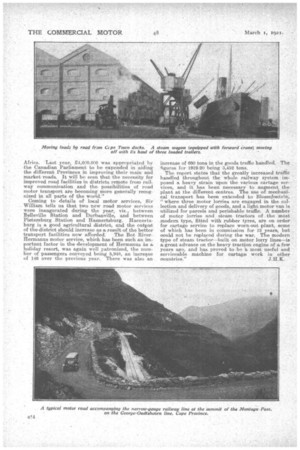ROAD TRANSPORT IN SOUTH• AFRICA.
Page 17

Page 18

If you've noticed an error in this article please click here to report it so we can fix it.
How the Sub-Continent is Seriously Handicapped Through the Want of Good
Feeder Roads.
" HE SUCCESS of fast road transpOrt depends
upon the condition of the roads, and, unfor
tunately, South Africa is seriously handicapped in this respect. I have consistently urged the necessity for improved road communication as an aid to development, but as roads do not fall Within the scope of the Railway Administration, I am unable to do more than draw attention to the matter."
Thus Sir William Hoy, ;general manager of the Union of South Africa RailWays and Harbours, in his latest official—and voluminous—report on the work of the -Railway Administration for the year ended March 31st, 1920, several pages of which are devoted
to road motor transport. Throughout the whole country, he tells us, there is a growing demand for modern means of transport and improved communication, and, so far as this is indicative of a desire and intention to develop the latent sources of the Union, the .demand is gratifying, and deserving of sympathetic consideration. Even in many developing districts the construction of new railways is not justified as a oornmercial proposition under present-day conditions.
Road motor services gauge the possibilities of a district, and, at the same time, stimulate developmerit, without incurring the heavy capital outlay necessary for the construction of the cheapest type of railway. Motoeservices also have the advantage of flexibility. They can be transferred to other routes, and arrangements made, as in the case of the Durbanville service, to' deliver traffic to and collect it direct from the farnis.. Motor services, of course, have their limitations, hut are decidedly useful in the pioneer stage, and, in reviewing the financial results of such services as are run at a loss, it should be borne in mind that the loss is less than would have been. the case with a branch line of railway.
Sir William Hoy, writing at some lenstli, points the moral to be deduced from the provision of good feeder roads. in a country like South Africa. To emphasize his point, he quotes freely from the annual reports of the generalmanager of the Nigerian Railways—a subject dealt with some time ago in. The Commercial 'Motor—from the Commissioner of Railways for Queensland, and from the last yearly statement of the linenos Ayres Western Railway Co., and
he sums up in saying:— . ." Good feeder roads leading to, and linking up with, the railway are very badly needed in South Africa. Last year, £4,000,000 was appropriated by the Canadian Parliament to be expended in aiding the different Provinces in improving their main and market roads. It will be seen that the necessity for improved road facilities in districts remote from railway communication and the Possibilities of road motor transport are becoming more generally recognized in all parts of the world."
Coming to details of local motor services, Sir William. tells 'us that two new road motor services were inaugurated during the year, viz., between Belleville Station and Durbanville, and between Pietersburg Station and Ha_enertsburg. Haenertsburg is a good agricultural district, and the output of the district should increase as a. result of the better transport facilities now afforded: The Bot Riverifermanus motor service', which has been such an important factor in the development of Herraanus ks holiday resort, was again well patronized, the number of passengers conveyed being 5,948, an increase el 146 over the previous year. There Was also an increase of 630 tons in the goods traffic handled. The ftgures. for 1919-20 being 3,452 tons.
The report states that the greatly increased traffie handled throughout the whole railway System imposed a heavy strain upon the various cartage services, and it has been necessary to augment the plant at the different centres. The use of mechanical transport has been extended to Bloemfontein, "where three motor lorries are engaged in the collection and delivery of goads, and a light motor van is utilized for parcels and perishable traffic. A number of motor lorries and steam tractors of the most modern type, fitted with rubber tyres, are on .order for cartage service to replace worn-out plant, some of which has been in commission for 13 years, but. could not be replaced during the war. The modern type of steam tractor--built on motor lorry lines—is a great advance on the heavy traction engine of a few years ago, and has proved to be a most useful and service,able machine for cartage avork in other
countries." J.H.K.
































